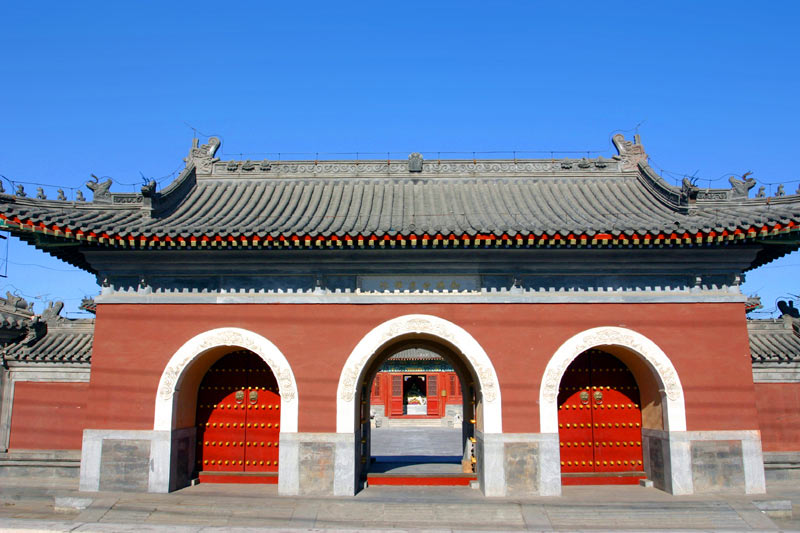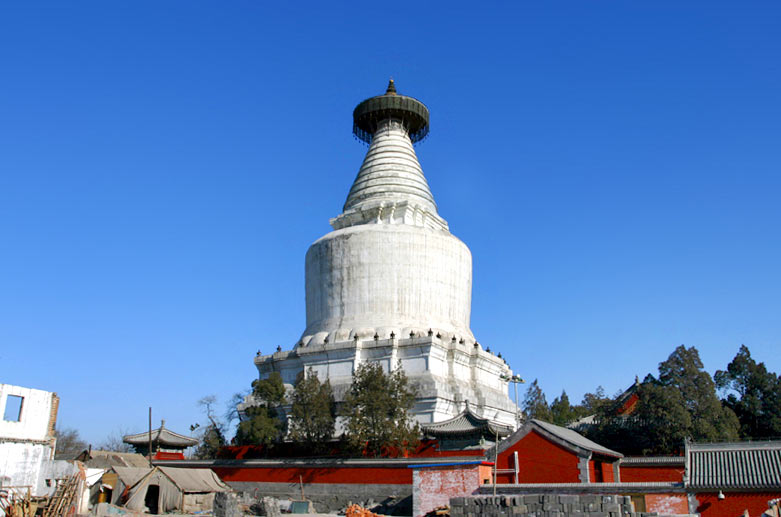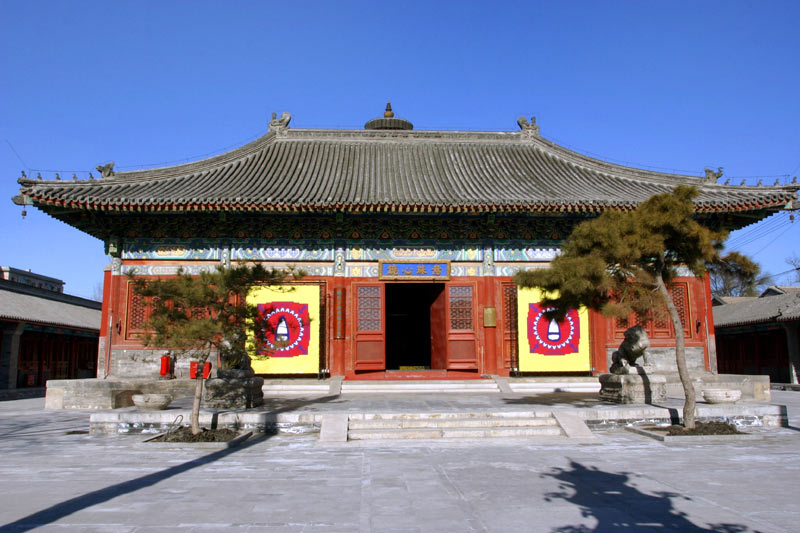White Dagoba Temple (Baita Si) is located at the Western District inside Beijing City. It got its name from a white old dagoba inside the temple. The White Dagoba standing over 50 meters high. It is the largest Dagoba from the Yuan dynasty (1280-1368AD) still in existence. The temple was completed in under the supervision of a Nepalese architect and it was considered an aesthetic masterpiece. White Dagoba Temple originally had the name "Temple of Great Holy Longevity and Eternal Peace". It was named "Miaoyingsi" after it was rebuilt in the Ming Dynasty (1368 - 1644). The common people call the Temple by its more popular name, the White Dagoba Temple.

White Dagoba Temple (Baita Si or Miaoyong Si)
History
The White Dagoba has its own history of more than 700 years. It was initially built from 1271 to 1279 during the Yuan Dynasty and was designed and constructed by a famous Nepali at that time. In the same year after the dagoba was built, a magnificent temple was constructed with the dagoba as its centerpiece. Altogether, this Nepali built three dagobas in the whole of China, one in Tibet, one in Wutai Mountain, in Shanxi Province (one of the four famous Buddhist mountains in China) and the third one here in White Dagoba Temple. These dagobas are the combinations of Chinese and Nepalese cultures.
The construction of dagobas on a large scale reflected the exploitation of Lamaism by the ruling class during the Yuan Dynasty to carry out ideological domination. During the Ming and Qing dynasties Lamaism continued to develop in China and more Lamaist dagobas were erected. Dagnhas, in fact, became the main style for tombs of eminent Buddhists, monks and lamas alike, so they were also called monks' tombs. The most famous Lamaist dagobas include the White Dagoba at Tayuan Temple on Wutai Mountain, the White Dagoba at Beijing's Beihai Park, and the White Dagoba at Lianxing Temple by the Slimmer West Lake in Yangzhou. Sometimes a single temple has several dozen or several hundred such dagobas. Some pagodas built on vajrasanas or across roads also have such a structure on top.

White Dagoba of White Dagoba Temple
In 1368 during the Yuan Dynasty, the Temple was destroyed by thunder and fire, only the dagoba remained intact. The Temple was reconstructed in 1457 during the Ming Dynasty and was repaired in the following dynasties. Most of the buildings you can now see inside the Temple were constructed in the Qing Dynasty (1644 - 1911).
Renovated in 1998 and 2003, this temple features the largest Tibetan pagoda (also called chorten, dagoba or stupa) in China, towering over the neighborhood at 51m (167 ft.) tall.

White Dagoba Temple (Baita Si or Miaoyong Si)
Architecture
There are altogether three Halls in White Dagoba Temple. The first one is exhibits on the history of the temple, as well as a display of several of the priceless Buddhist treasures that were discovered when the Pagoda was being renovated in 1978. The second Hall is an impressive display called the Hall of 10,000 Buddhas. Al-though there are not actually 10,000 statues in the Hall, there are over 7,000 of them, Walking into the Hall is a breathtaking sight, the place is literally covered in Buddha statues on all four walls. Behind this Hall is the Hall of Seven Buddhas, Which is home to seven large Buddha statues, as opposed to the thousands of little ones, behind this is the White Pagoda itself. Although visitors are not allowed to go up on the Pagoda itself, there is really not much to go up on, there are no doors leading into the structure.
The White Dagoba is fifty one meters high like a gourd. The whole body was covered by chalkiness.Its upper part is like a conic neck divided into three fragments.
Its base is a three-layered square with a height of nine meters. Thirty six copper bells hang to a tray, also made of copper, under the roof of the dagoba. They sound beautifully well when wind blows unto them. This dagoba is on the opposite side of the White Dagoba in Beihai Park and fifteen meters higher. The Temple's White Dagoba is the biggest in Beijing and is considered the largest Lama Stupa of the Yuan Dynasty (1271 - 1368) in present day China. There are many precious Buddhist cultural relics hidden inside the roof of the dagoba and are now displayed at the Temple. For example, there are the scriptures written by Emperor Qianlong of the Qing Dynasty, and the little carved Buddhas figures.
The temple has undergone numerous reconstructions. The Dajue Dian (Hall of the Great Enlightened Ones), the first building, contains thousands of little Buddhas in glass cases, set into the columns. An earthquake in 1976 turned up numerous artifacts, some of which are now on display in the museum. You'll find Buddhist statuary demonstrating ritualistic hand positions (mudra), a sutra copied out by the Qianlong emperor, and vivid thangka (silk hangings depicting Buddhist images). Just to the east is a potentially fascinating temple, Lidai Diwang Miao (Temple for Emperors of Past Dynasties). Constructed during the 1530s to house the ancestral tablets of the emperors of "Chinese" dynasties -- the Han, Tang, and Song, it was expanded by Qing emperors to include not only their Ming predecessors, but also the "barbarian" rulers of the Liao, Jin, and Yuan.
The Temple was formally opened in 1980. (CCNPIC Tony Xie)
(Article Resource: beijingservice.com)